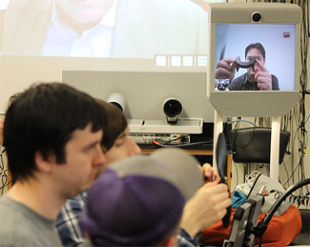How a JMU physics lab is improving higher ed. efficiency
Science and Technology
A robot circles the lab, answers student questions and provides one-on-one assistance with their projects. Well, it's not really the robot giving the assistance, but a faculty member or industry professional with expertise in the subject area who is piloting the robot from some place hours away from Harrisonburg.
The robot, called a "Beam" by its inventors, Suitable Technologies of Palo Alto, Calif., is one of the new technology enhancements opening up Room 2312 in the Physics-Chemistry Building to places well beyond the JMU campus. While using technology to facilitate distance learning is no longer revolutionary, the Beam—basically a two-way video communication device on wheels—does take it a step further by enabling teachers from remote locations to communicate directly with students at their workstations.
"STEM classes are almost all hands-on. You think about that and say, 'How do we do that?'" said Nick Swayne, director of 4-VA at JMU. "It really doesn't work well if you've got 10 students in the classroom and the professor is at Virginia Tech and you're building a robot. If you've got a problem and it's not working, I want a professor who is going to be there. The Beam allows the remote professor to walk around the room and interact with students."
The Beam is being operated this year by three engineers at Nova Labs, a maker space in Reston. Fred Briggs, Ted Markson and Bo Pollett are providing guidance to students who are building drones. The teacher-of-record for the course, Dr. Kevin Giovanetti, professor of physics and astronomy, provides the theory behind the project.
In the future, the technology in the lab could be used to share courses among universities and perhaps reduce the number of courses that are cancelled due to low enrollment. "There are so many faculty who are experts in certain areas, but that expertise is not necessarily duplicated at other institutions," Swayne said. "If you have somebody at JMU who is an expert on something, but they only have five or six students sign up, could we have five or six students at other universities taking that class with them?"
After proving the concept at JMU, the next step, Swayne said, will be equipping other universities with similar technology.
By Josh Kelly ('15), JMU Public Affairs

